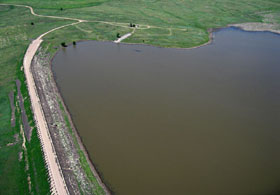
| Finney State Lake and
Wildlife Area, Kansas
J.S. and S.W. Aber
Brenda Zabriskie |
Finney State Lake and Wildlife Area is a small reservoir built in the 1930s on a tributary of Pawnee River. It's located approximately 8 miles north and 2 miles west of Kalvesta, in southwestern Kansas. The area includes 660 acres that are managed for wildlife and fishing. The entire area is open for hunting, but fishing is possible only during infrequent wet years when the reservoir contains water from upstream runoff. During dry spells, the lake floor may be planted with wheat or alfalfa (Finney 2016).

| Many such dams and lakes were constructed across Kansas during the Great Depression by the Civilian Conservation Corps as work projects. Stone sign in the wall on the dam near the outlet tower.
|
The area is located in a semiarid climate in which local precipitation averages about 20 inches (~50 cm) per year with most precipitation coming during the period May through August (HPRCC 2015). Annual precipitation is highly variable, however, ranging from nearly 30 inches (1973) to less than 6 inches (1988). The region is subject to recurring drought. The lake was designed originally to cover approximately 120 acres, but rarely does so (Finney 2016). The failure of this reservoir as a perennial lake may be attributed to a combination of the dry climate, small drainage basin, and upstream extraction of surface and ground water, primarily for agriculture.

| Ground views from the dam and outlet tower looking toward the lake basin. Completely dry (left), which is typical most years. A grove of mature trees occupies the valley bottom. Water pool (right) submerges the trees, a rare sight in 2015.
|  |
We have visited the area several times during the past decade, and the reservoir has been completely dry most of the time. The spring of 2010 was unusually wet with heavy rain, and we conducted kite aerial photography (KAP) in late May. The month of May 2015 was likewise exceptionally wet across the southern Great Plains and Rocky Mountain regions (see statewide precipitation). In fact, May 2015 was the wettest month for the whole United States since records began in 1895 (NOAA 2015).
During the past few years, drought conditions in central and western Kansas have diminished from extreme and exceptional categories. By late June 2015, drought was completely gone in the Finney vicinity (see drought monitor), when we again conducted KAP. At that time, the lake covered an estimated 50-60 acres (Finney 2016). The wet conditions of 2015 continued in 2016 (see drought monitor). We returned in the early fall of 2016 with students from Emporia State University, and we found considerable water still present behind the dam.

KAP in 2010 (JSA & BZ)

| Overviews of the dam with a small puddle of water behind the dam. Lush green prairie surrounds the lake, and trees stand on dry land in the valley bottom (right). Kite flyers in lower left corner (left).
|  |
KAP in 2015 (SWA & JSA)

| Overview of the dam and lake (left) and upstream portion of lake (right). Note submerged grove of trees in the middle of lake; some of these trees died from prolonged submergence.
|  |

| Left: dam and outlet tower (<) with the boat ramp visible at upper right. Left: vertical shot over the dam. The dark spot (<) is the kite shadow, and light spot (>) is the so-called hot spot, where the camera and sun are in direct alignment.
|  |

| Left: looking straight northward. The tree-lined channel to left is the main tributary for the lake. Right: view toward northeast showing typical farm land and a small pond.
|  |
KAP in 2016 (JSA & ESU students)

| Overview of the lake and dam (left), and a closer shot of the southwestern end of the lake showing the boat ramp. An algal bloom is visible on the lake surface, and shore vegetation displays distinctive fall colors.
|  |

| Looking upstream (left) with extensive mud flat exposed by evaporating water. Note distinctive mowing patterns. Close-up shot (right) of the mud flat showing dead trees and algae in the water.
| 
|
References
- Finney 2016. Finney State Fishing Lake, Kansas Department of Wildlife, Parks, and Tourism. Accessed online Finney.
- High Plains Regional Climate Center (HPRCC) 2015. Kalvesta, Kansas (144161). Accessed online (HPRCC).
- NOAA 2015. National Overview – May 2015. NOAA, National Centers for Environmental Information. See online report.


| The authors (JSA & SWA) test a camera rig prior to flight.
|
 Return to airphoto gallery
or Great Plains airphoto homepage.
Return to airphoto gallery
or Great Plains airphoto homepage.
All text and images © by the authors (2016).




![]() Return to airphoto gallery
or Great Plains airphoto homepage.
Return to airphoto gallery
or Great Plains airphoto homepage.